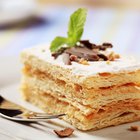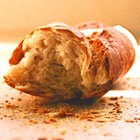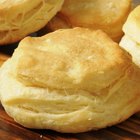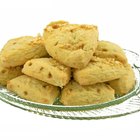
Britain's well-loved scones and America's equally cherished biscuits are culinary first cousins. Both are light and flaky quick breads, made with flour and fat and a chemical leavener, such as baking powder or baking soda. In the U.S., plain or savory versions are usually called biscuits and sweet versions are called scones. In Britain, scones are generally sweet. In either case, they must be baked in a hot oven to reach their maximum height and lightness.
Scones vs. Biscuits
There's enough overlap between scone recipes and biscuit recipes that it's difficult to generalize about them. British scone recipes are often made with butter and cream, though buttermilk is also sometimes used. American biscuits might use shortening or -- more traditionally -- lard as their fat, and are likelier to add eggs for richness. More than ingredients, texture defines the difference. American-style biscuits typically keep the fat in larger pieces, and are flaky as a result. Scone recipes reduce the fat to crumb-size, and pat the dough into shape rather than kneading it. This produces a softer result that's more like a cake.
Baking Temperatures
For a scone or biscuit to reach its fullest height and lightest crumb, it should be baked in a hot oven. Most recipes suggest a temperature of 425 degrees Fahrenheit, and some recommend 450 F. For the quickest rise, others preheat the oven to 500 F and drop it to 450 F once the scones are in the oven. That way, the heat you lose by opening the oven takes it down to the intended baking temperature. Be careful to stand away from the oven door when you open it, or your eyebrows might suffer dire consequences.
Why It's Important
The heat is as important to the final quality of your scones as the ingredients and your mixing technique. Your goal is to have the scone reach its full height within the first few minutes of baking, then finish baking after just a few more minutes. Baking soda and baking powder both give their most powerful lift at high temperatures, and steam evaporating from the dough will also help it rise. The high temperature and quick baking time also produce a delicately crisp crust, which would grow thicker and crunchy with a longer baking time.
A Few Pointers
Scone recipes might call for baking soda, baking powder, self-rising flour, or any combination of the three. Each can produce a light and lofty scone, when handled correctly. Baking soda requires an acidic ingredient such as buttermilk or cream of tartar to make it rise, while baking powder does not. Soda produces a browner crust, so if you're using baking powder or self-rising flour you might want to brush the tops of the scones with milk or a beaten egg. That produces a rich golden color, compensating for the lack of soda.
Related Articles
Why Are My Biscuits Always Flat?

What Is Docking Used for in Baking?

How to Get Pizza Crust to Brown

Can Self Rising Flour Substitute for ...

How to Make Bread Tender
Can I Store Biscuit Dough Overnight?

Differences Between French & Italian ...
Can You Refrigerate Homemade Yeast ...

How to Make Scones

How to Make Southern Buttermilk ...

Does It Matter if I Substitute Baking ...

Custard vs. Pastry Cream

Butter Substitute for Baking Scones

How to Bake Bread in the Oven

Why Use Baking Powder in Pancake Batter?

What Is the Difference Between a Bagel ...

How to Cook Cinnamon Rolls in the ...

What Is Artisan Bread?

What Is the Difference Between Scones & ...

Do I Cook Frozen Broccoli Before Baking ...
References
- On Food and Cooking: The Science and Lore of the Kitchen; Harold McGee
- King Arthur Flour: Classic Scones
- Joe Pastry: Making Cream Scones
Writer Bio
Fred Decker is a trained chef and certified food-safety trainer. Decker wrote for the Saint John, New Brunswick Telegraph-Journal, and has been published in Canada's Hospitality and Foodservice magazine. He's held positions selling computers, insurance and mutual funds, and was educated at Memorial University of Newfoundland and the Northern Alberta Institute of Technology.
Photo Credits
MASH/Digital Vision/Getty Images